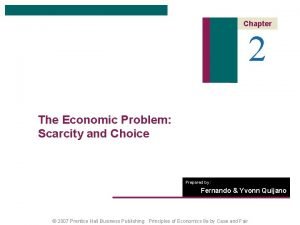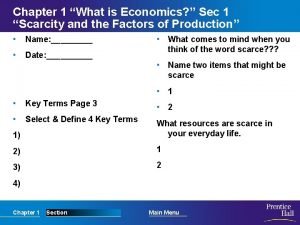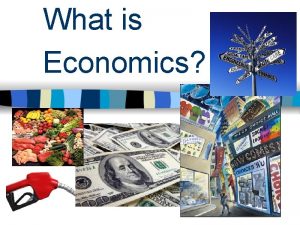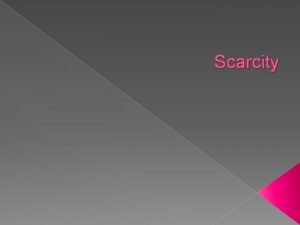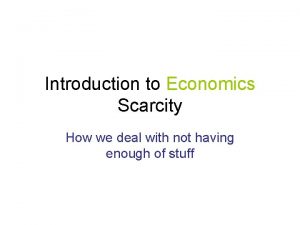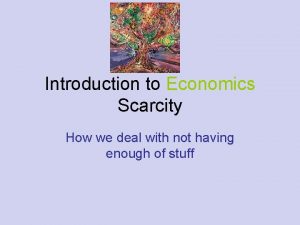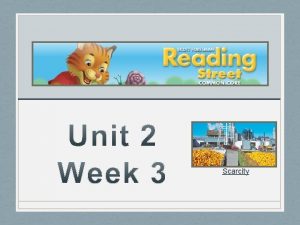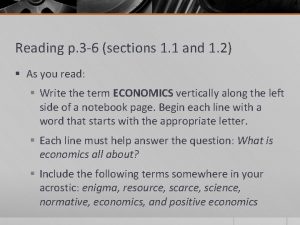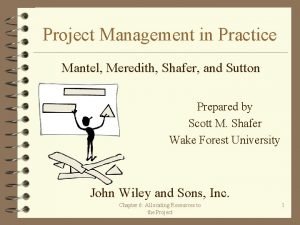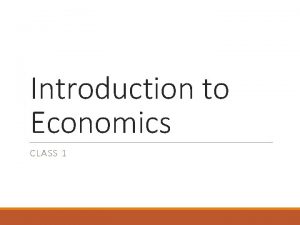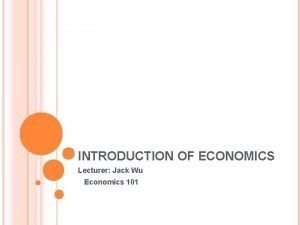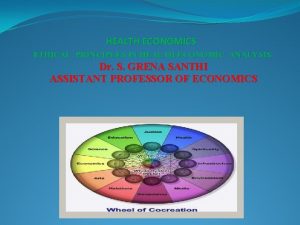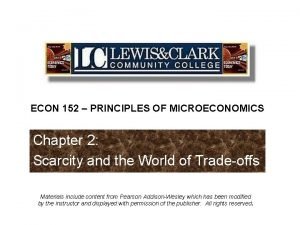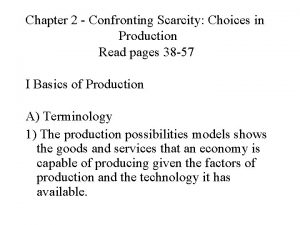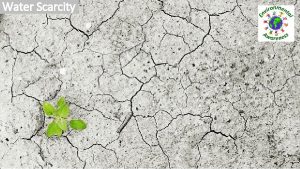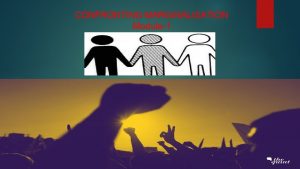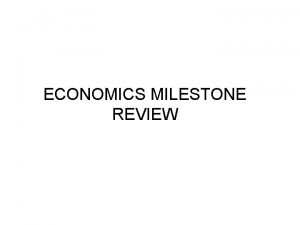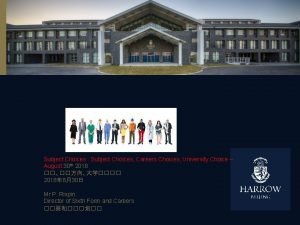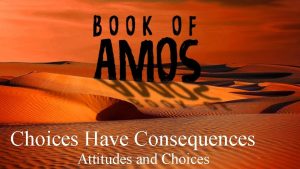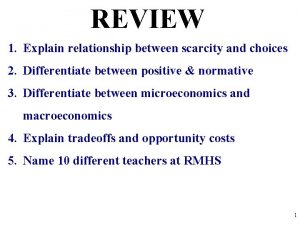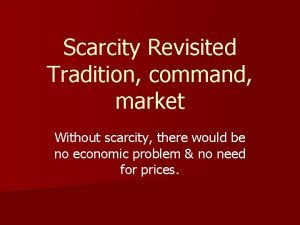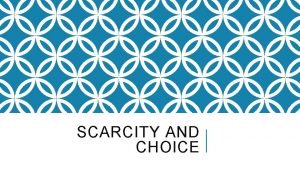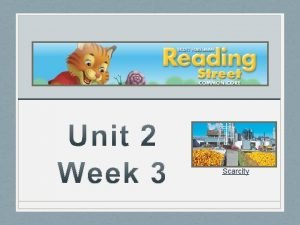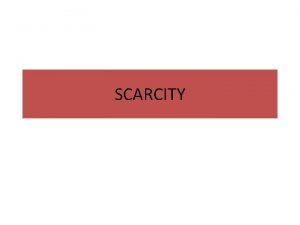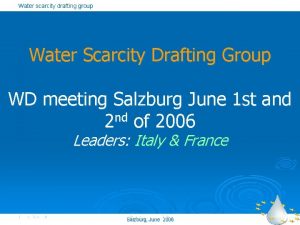Chapter 2 Confronting Scarcity Choices in Production Review
























- Slides: 24

Chapter 2 Confronting Scarcity: Choices in Production

Review § What is the economic way of thinking? – Scarcity forces us to choose and economists analyze opportunity costs when analyzing choices – People are motivated to maximize their self interest – Individuals maximize choices by engaging in marginal decision making

Factors of Production § Definition: resources available to an economy for the production of goods and services § Factors of production (FOP) create utility. § Utility is the value or satisfaction that people derive from the goods or services they consume

Factors of Production § Land (natural resources)-resources of nature that can be used in the production of goods and services – Must be found in nature – Expansion occurs through: § Discovery of more § Discovery of new use § New ways of extraction

Factors of Production § Labor-human factor in production – Natural ability – Human capital – Increase labor through § Increasing number of people available § Increasing human capital

Factors of Production § Capital-resources produced for use in the production of goods and services – Resource must have been produced – Resource can be used to produce other goods and services – THIS DOES NOT MEAN FINANCIAL CAPITAL (money)

Factors of Production § Entrepreneurs change the way that the factors of production are used by putting new technologies to work § Entrepreneur person who seeks to earn profits by finding new ways to organize the factors of production (sometimes classified as the fourth factor of production) § Technology knowledge that can be applied to production of goods and services

Case in Point: Technology Cuts Costs, Boosts Productivity and Profits § Read p. 41 § Who are the winners and losers from technology? – Consumers – Producers – Workers

Land, labor or capital? § § § § An unemployed factory worker A college professor The SMCHS library Yellowstone National Park An untapped deposit of natural gas The White House A power plant

Production Possibilities Curve § § § CSU Monterey Bay built on site of Fort Ord Shift from military use to civilian use Definition: Model that shows goods and services that an economy is capable of producing given the factors of production and technology it has available

Production Possibilities Curve § Assumes that only two goods can be produced § Any increase in one good means you can produce less of the other § Assumes that factors of production are fixed

Production Possibilities Curve § The PPC is downward sloping – Reflects scarcity § The PPC is bowed out – Curve gets steeper as we move from left to right – “Producing an additional good on horizontal axis requires a greater sacrifice of the good on the vertical axis than did previous units produced” (Tregarthen & Rittenberg, 2000, p. 57)

Production Possibilities Curve § The PPC is bowed out – The absolute value of the slope of any production possibilities curve (PPC) = the opportunity cost of an additional unit of a good on the horizontal axis – Steeper the slope, the greater the opportunity cost of producing that good – Illustrates the law of increasing opportunity cost

Calculating Opportunity Cost § Opportunity cost = what is given up/what is obtained § Economy can produce either 40 houses or 20 office buildings § OC of houses = 20 office buildings/40 houses=. 5 office buildings § OC of office buildings = 40 houses/20 office buildings = 2 houses § Try “Try It Yourself” 2 -2 on p. 49

Production Possibilities Curve § Law of increasing opportunity cost – As an economy moves along its PPC in the direction of increased production of one good, the opportunity cost of additional units of that good increase – Law applies because as one moves closer to one end of the curve, resources transferred from one use to the other had greater and greater comparative advantage

Production Possibilities Curve § Comparative advantage is when the opportunity cost of producing that good or service is lower for a particular economy than any other – International trade theory is based on comparative advantage

Production Possibilities Curve § Specialization implies that an economy is producing goods and services in which it has a comparative advantage – People work and use the income they earn to buy goods and services from people who have a comparative advantage in doing other things – What would life be like without specialization? Hong Kong vs. United States

Production Possibilities Curve § Movement along the PPC means that all factors of production are being maximized (point A) § Production within the curve means that factors of production are being used inefficiently (point B) – Idle factors of production – Inefficient production – Could increase production of both goods

Production Possibilities Curve § Production outside of the PPC is impossible without economic growth – Increased educational levels – Change in technology – Increased quality or quantity of labor and capital

Applications of the PPC Model § In order to allocate resources efficiently, then each nation should specialize in producing products for which they have a comparative advantage § Nations should trade in order to get the goods and services they need – Trade results in more production § Failure to specialize means that the world economy would be producing inside the global PPC

Production Possibilities and Economic Growth § An outward shift of the PPC indicates economic growth. § Economic growth raises standards of living, even in the continuing face of scarcity. § Economic growth is a sustained increase in a nation’s production of goods and services.

Production Possibilities and Economic Growth § The history of world economic growth raises important questions about the ability of nations to deal with the ever-present problem of scarcity. – Rich versus poor nations – Conditions that favor growth – How can growth be promoted? – How can poverty be reduced?

Production Possibilities and Economic Growth § Economic growth occurs through – Increases in educational levels – Changes in technology – Increases in quantity or quality of labor and capital – Innovation

Institutions Matter for Economic Growth
 Proses post production
Proses post production Chapter 9 making healthy food choices review answers
Chapter 9 making healthy food choices review answers The economic problem of scarcity
The economic problem of scarcity How do economists use the phrase guns or butter
How do economists use the phrase guns or butter Chapter review motion part a vocabulary review answer key
Chapter review motion part a vocabulary review answer key Causes of scarcity
Causes of scarcity Opportunity cost
Opportunity cost The basic economic problem results from scarcity.
The basic economic problem results from scarcity. Scarcity lesson plan
Scarcity lesson plan Opportunity costs and trade offs
Opportunity costs and trade offs Causes of scarcity
Causes of scarcity Scarcity, choice and opportunity cost example
Scarcity, choice and opportunity cost example Scarcity
Scarcity Scarcity forces tradeoffs
Scarcity forces tradeoffs Relationship between economics and scarcity
Relationship between economics and scarcity Scarcity entrepreneurship definition
Scarcity entrepreneurship definition Scarcity
Scarcity Resources scarcity
Resources scarcity Resources scarcity
Resources scarcity Resources scarcity
Resources scarcity Resources scarcity
Resources scarcity Resources scarcity
Resources scarcity Scarcity
Scarcity Traditional economy political cartoon
Traditional economy political cartoon Ricardian rent definition
Ricardian rent definition


